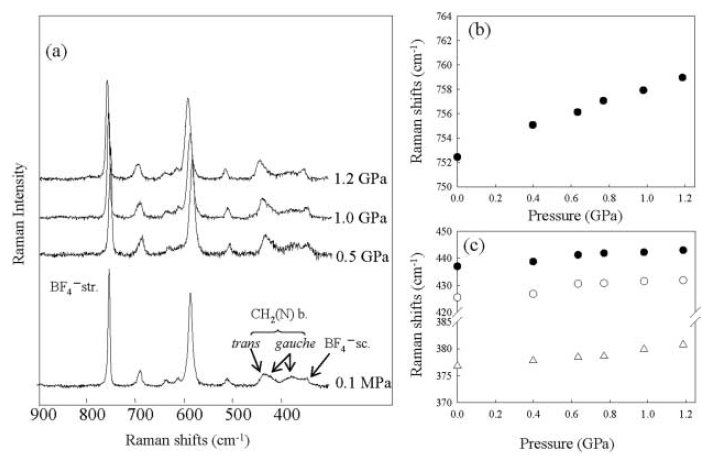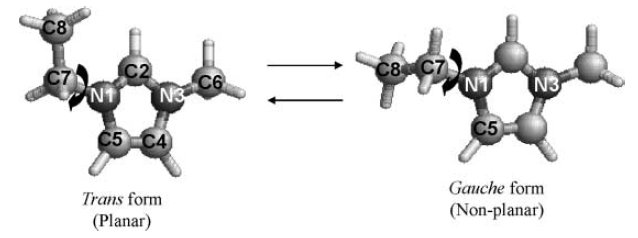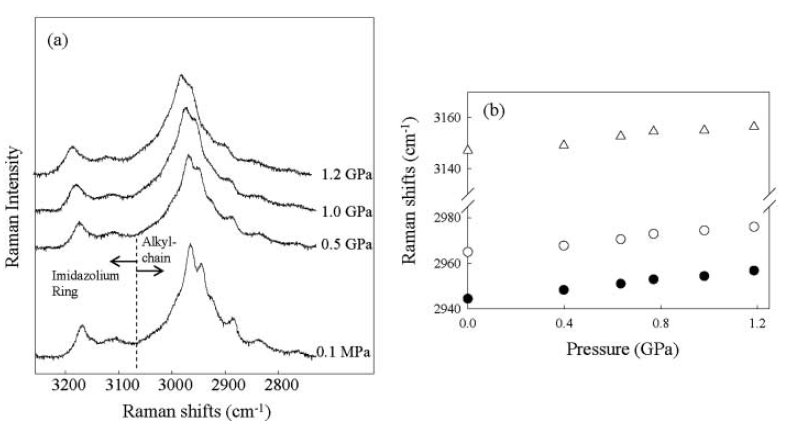|
|
Fig. 1 |
|
|
Fig. 2 (a) Raman CH stretching spectra and (b) the frequency shifts of [emim][BF4] as a function of pressure. The open triangle, closed and open circles represent the mixing band of the C(2).H, C(4).H, C(5).H ass mode of the imidazolium ring, the C(8).H ass, and C(6).H ass modes of the alkyl-chain, respectively. |
 |
Fig. 3. (a) Raman spectra in the low frequency region of [emim][BF4] as a function of pressure. Pressure-induced frequency shifts of (b) BF4 stretching band, and (c) the imidazolium-ring in-plane bending and CH2 (N) bending bands of [emim][BF4]. The open triangle, open and closed circles represent the gauche, gauche, and trans conformers for the CCNC angle of [emim]+ cation, respectively. |
References
[2] H. Itho, K. Naka, andY. Choujo, Synthesis of gold nanoparticles modified with ionic liquid based on the imidazolium cation, J. Am. Chem. Soc. 126 (2004), pp. 3026-3027.
[3] T. Sato, G. Matsuda, and K. Takagi, Electrical properties of novel ionic liquids for electric double layer capacitor applications, Electrochim. Acta 49 (2004), pp. 3603-3611.
[4] M. Kanakubo, T. Umecky, Y. Hiejima, T. Aizawa, H. Nanjo, and Y. Kameda, Solution structure of 1-butyl-3-methylimidazolium hexafluorophosphate ionic liquid saturated with CO2: Experimental evidence of specific anion-CO2 interaction, J. Phys. Chem. B 109 (2005), pp. 13,847-13,850.
[5] T. Takekiyo, N. Hatano, Y. Imai, H. Abe, and Y. Yoshimura, Pressure-induced phase transition of 1-butyl-3-methylimidazolium hexafluorophospahte [bmim][PF6], High Press. Res. 31 (2011), pp. 35-38.
[6] Y. Imai, T. Takekiyo, H. Abe,Y.Yoshimura, Pressure- and temperature-induced Raman spectral changes of 1-butyl-3-methylimidazolium tetrafluoroborate, High Press. Res. 31 (2011), pp. 53-57.
[7] T. Takekiyo, N. Hatano,Y. Imai, H. Abe, andY.Yoshimura, Conformational preferences of two imidazolium-based ionic liquids at high pressures, Chem. Phys. Lett. 511 (2011), pp. 241-246.
[8] Y. Yoshimura, T. Takekiyo, Y. Imai, and H. Abe, High pressure phase behavior of two imidazolium-based ionic liquids, [bmim][BF4] and [bmim][PF6], in Ionic Liquids-Classes and Properties, S. Handy, ed., Intech, Croatia, 2011, Chap. 8, pp. 171-186.
[9] L. Su, L. Li, Y. Hu, C. Yuan, C. Shao, and S. Hong, Phase transition of [Cn-min][PF6] under high pressure up to 1.0GPa, J. Chem. Phys. 130 (2009), 184503 (pp. 1-4).
[10] L. Su, M. Li, X. Zhu, Z. Wang, Z. Chen, F. Li, Q. Zho, and S. Hong, In-situ crystallization of low-melting ionic liquid [BMIM][PF6] under high pressure up to 2GPa, J. Phys. Chem. B 114 (2010), pp. 5061-5065.
[11] H.K. Mao, P.M. Bell, J.W. Shaner, and D.J. Steinberg, Specific volume measurements of Cu, Mo, Pd, and Ag and calibration of the ruby R1 fluorescence pressure gauge from 0.06 to 1 Mbar, J. Appl. Phys. 49 (1978), pp. 3276-3283.
[12] N.E. Heimer, R.E.D. Sesto, Z. Meng, J.S. Wilkes, and W.R. Carper, Vibrational spectra of imidazolium tetrafluoroborate ionic liquids, J. Mol. Liquids 124 (2006), pp. 84-95.
[13] H.-C. Chang, J.-C. Jiang, C.-Y. Chang, J.-C. Su, C.-H. Hung, Y.-C. Liou, and S.H. Lin, Structural organization in aqueous solutions of 1-butyl-3-methylimidazolium halides: A high-pressure infrared spectroscopic study on ionic liquids, J. Phys. Chem. B 112 (2008), pp. 4351-4356.
[14] Y. Umebayashi, T. Fujimori, T. Sukizaki, M. Asada, K. Fujii, R. Kanzaki, and S. Ishiguro, Evidence of conformational equilibrium of 1-ethyl-3-methylimidazolium in its ionic liquid salts: Raman spectroscopic study and quantum chemical calculations, J. Phys. Chem. B 109 (2005), pp. 8976-8982.
Last Modified: May 1, 2012

